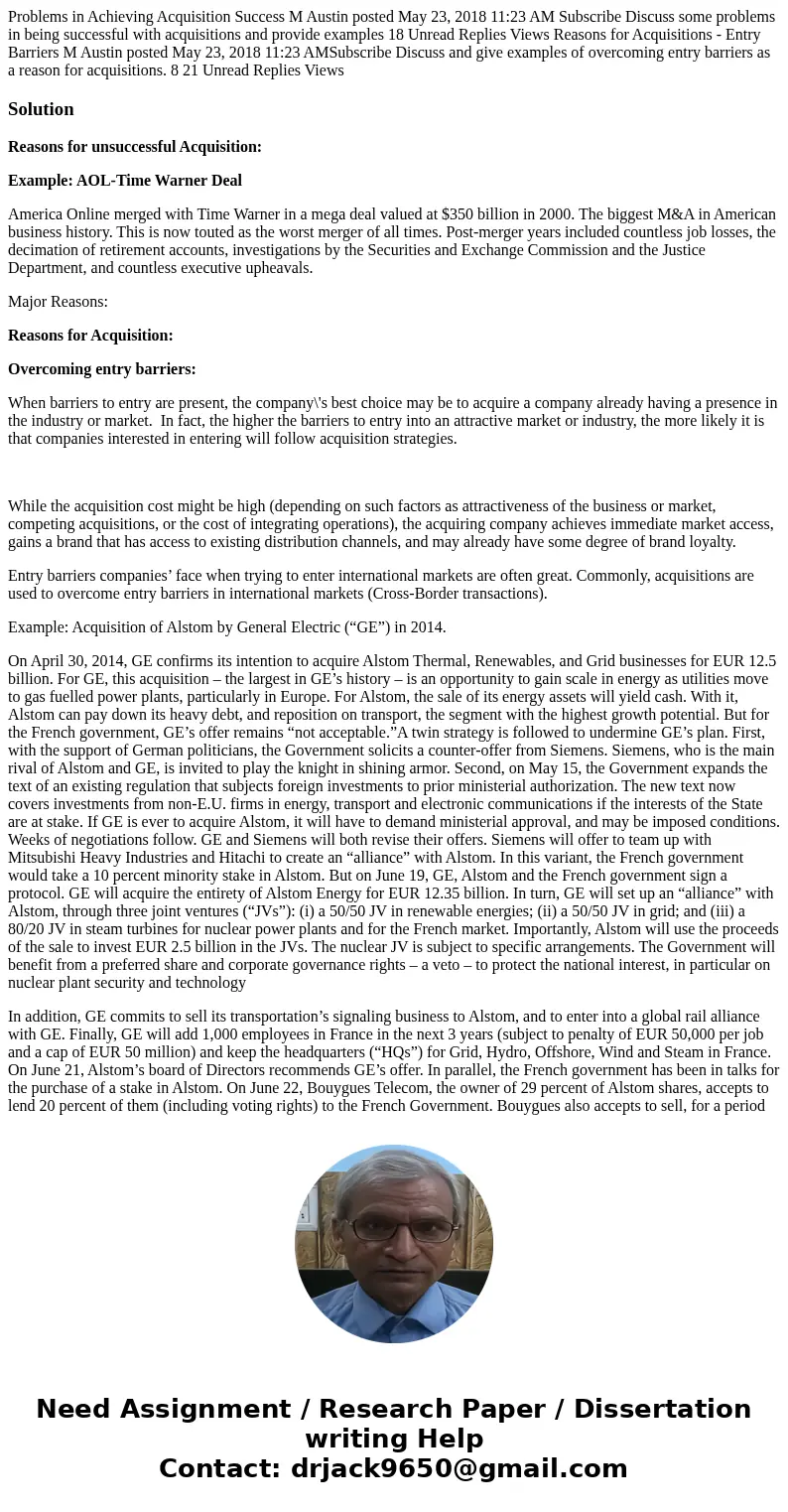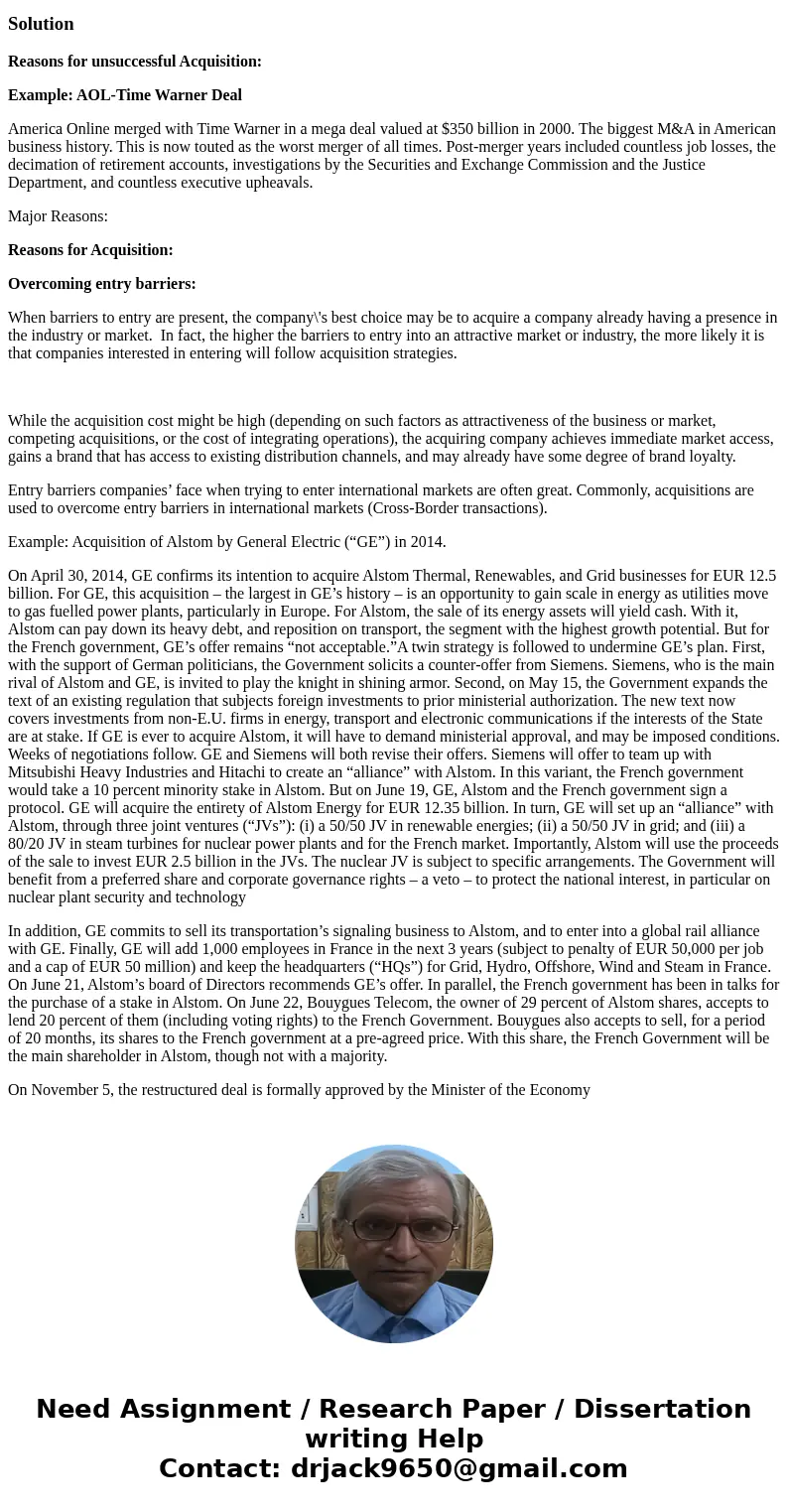Problems in Achieving Acquisition Success M Austin posted Ma
Solution
Reasons for unsuccessful Acquisition:
Example: AOL-Time Warner Deal
America Online merged with Time Warner in a mega deal valued at $350 billion in 2000. The biggest M&A in American business history. This is now touted as the worst merger of all times. Post-merger years included countless job losses, the decimation of retirement accounts, investigations by the Securities and Exchange Commission and the Justice Department, and countless executive upheavals.
Major Reasons:
Reasons for Acquisition:
Overcoming entry barriers:
When barriers to entry are present, the company\'s best choice may be to acquire a company already having a presence in the industry or market. In fact, the higher the barriers to entry into an attractive market or industry, the more likely it is that companies interested in entering will follow acquisition strategies.
While the acquisition cost might be high (depending on such factors as attractiveness of the business or market, competing acquisitions, or the cost of integrating operations), the acquiring company achieves immediate market access, gains a brand that has access to existing distribution channels, and may already have some degree of brand loyalty.
Entry barriers companies’ face when trying to enter international markets are often great. Commonly, acquisitions are used to overcome entry barriers in international markets (Cross-Border transactions).
Example: Acquisition of Alstom by General Electric (“GE”) in 2014.
On April 30, 2014, GE confirms its intention to acquire Alstom Thermal, Renewables, and Grid businesses for EUR 12.5 billion. For GE, this acquisition – the largest in GE’s history – is an opportunity to gain scale in energy as utilities move to gas fuelled power plants, particularly in Europe. For Alstom, the sale of its energy assets will yield cash. With it, Alstom can pay down its heavy debt, and reposition on transport, the segment with the highest growth potential. But for the French government, GE’s offer remains “not acceptable.”A twin strategy is followed to undermine GE’s plan. First, with the support of German politicians, the Government solicits a counter-offer from Siemens. Siemens, who is the main rival of Alstom and GE, is invited to play the knight in shining armor. Second, on May 15, the Government expands the text of an existing regulation that subjects foreign investments to prior ministerial authorization. The new text now covers investments from non-E.U. firms in energy, transport and electronic communications if the interests of the State are at stake. If GE is ever to acquire Alstom, it will have to demand ministerial approval, and may be imposed conditions. Weeks of negotiations follow. GE and Siemens will both revise their offers. Siemens will offer to team up with Mitsubishi Heavy Industries and Hitachi to create an “alliance” with Alstom. In this variant, the French government would take a 10 percent minority stake in Alstom. But on June 19, GE, Alstom and the French government sign a protocol. GE will acquire the entirety of Alstom Energy for EUR 12.35 billion. In turn, GE will set up an “alliance” with Alstom, through three joint ventures (“JVs”): (i) a 50/50 JV in renewable energies; (ii) a 50/50 JV in grid; and (iii) a 80/20 JV in steam turbines for nuclear power plants and for the French market. Importantly, Alstom will use the proceeds of the sale to invest EUR 2.5 billion in the JVs. The nuclear JV is subject to specific arrangements. The Government will benefit from a preferred share and corporate governance rights – a veto – to protect the national interest, in particular on nuclear plant security and technology
In addition, GE commits to sell its transportation’s signaling business to Alstom, and to enter into a global rail alliance with GE. Finally, GE will add 1,000 employees in France in the next 3 years (subject to penalty of EUR 50,000 per job and a cap of EUR 50 million) and keep the headquarters (“HQs”) for Grid, Hydro, Offshore, Wind and Steam in France. On June 21, Alstom’s board of Directors recommends GE’s offer. In parallel, the French government has been in talks for the purchase of a stake in Alstom. On June 22, Bouygues Telecom, the owner of 29 percent of Alstom shares, accepts to lend 20 percent of them (including voting rights) to the French Government. Bouygues also accepts to sell, for a period of 20 months, its shares to the French government at a pre-agreed price. With this share, the French Government will be the main shareholder in Alstom, though not with a majority.
On November 5, the restructured deal is formally approved by the Minister of the Economy


 Homework Sourse
Homework Sourse